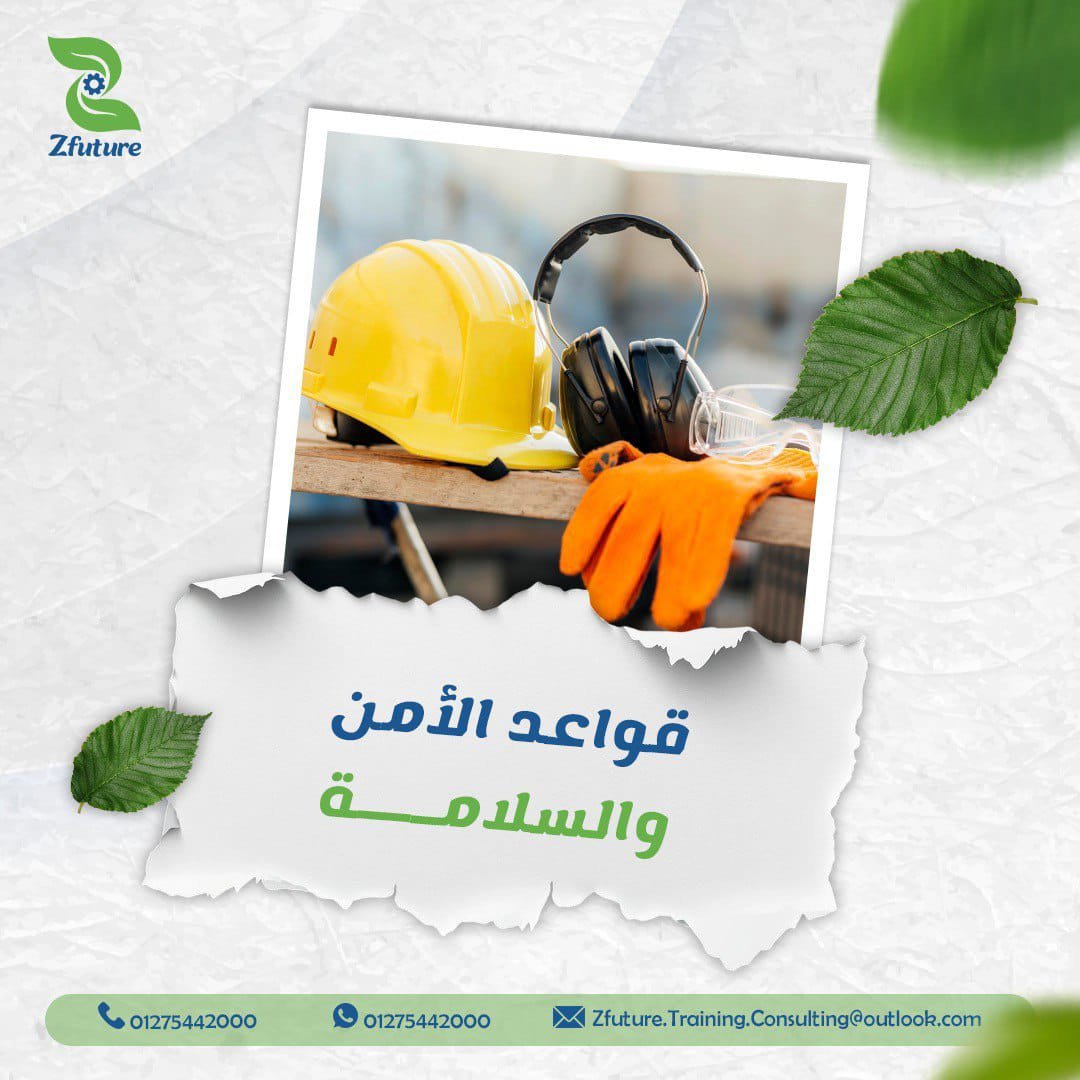Safety and security rules It forms the cornerstone of protecting individuals and property within work environments of all kinds, from small workshops to large factories and facilities. Adhering to occupational health and safety procedures not only ensures compliance with regulations, but also contributes to reducing accidents, increasing production efficiency, and creating a more stable and safe work environment.
With the increasing need to spread the culture Occupational safety The importance of using specialized platforms that provide training and practical content that helps workers and institutions implement these rules effectively has emerged. Among these platforms are :Zfuture Consulting and Training Company As a reliable tool to support knowledge and enhance awareness of security and safety in the modern workplace.
Contact us Now get a free consultation to know all the details about our services

What is the definition of Safety and security rules؟
Security and safety refers to the set of procedures and precautions that aim to protect individuals and property from accidents and injuries inside or outside the work environment. This includes the application of Safety and security rules In a systematic manner, it takes into account international and local standards to ensure a safe and stable environment. The concept is not limited to preventive aspects only, but extends to include occupational safety and health, risk management, and ensuring that every individual is aware of their responsibilities in reducing risks.
In general, it can be said that security and safety represent the framework that enables organizations to preserve their human and material resources by following and implementing security and safety procedures for facilities in workshops, factories, and various workplaces.
This definition lays the foundation for understanding the importance of setting Safety and security rules Professionalism as part of corporate culture contributes to increasing productivity, reducing accident rates, and creating a healthy work environment in line with sustainable development goals.
What are the security and safety requirements?
application Safety and security rules Within the work environment, safety can only be effectively achieved by adhering to basic conditions that ensure the safety of workers and the protection of facilities. These conditions are not limited to theoretical aspects, but also include practical procedures that regulate individual behavior and guide institutions toward a safer work environment. Among the most prominent occupational safety and security conditions that must be taken into account are the following:
Providing a safe working environment: by adhering to engineering and technical standards that reduce potential risks in workshops and factories.
Continuous training for employees: on prevention methods and how to deal with emergencies according to the facilities’ security and safety procedures.
Use Personal Protective Equipment (PPE) :such as helmets, gloves, and protective footwear to ensure injuries are minimized.
Prepare a security and safety plan: It includes clear steps for responding to incidents and evacuation procedures when necessary.
Conducting periodic checks of equipment and machinery: to ensure their compliance with Occupational health and safety standards.
Provide clear guidance and warning signs: within workplaces to alert to hazards and promote preventive awareness.
Customize occupational health and safety report forms: to monitor accidents and document observations periodically.
These conditions form the foundation of any effective occupational safety program and help create a comprehensive preventative culture that protects individuals and ensures unhindered production.
What is the security and safety plan?
A safety and security plan represents the practical framework that organizations rely on to ensure the protection of workers and property from potential hazards. It is not just a theoretical document, but rather an integrated program that defines the responsibilities, procedures, and implementation tools necessary to implement safety and security rules within the workplace. This plan aims to prevent accidents, reduce injuries, and respond effectively to emergencies, thus establishing a culture of occupational safety and health across various sectors. The most important components of a safety and security plan can be summarized as follows:
- Identifying potential hazards: Analyzing the work environment, whether in factories, workshops, or facilities, to discover sources of danger in advance.
- Establish preventive measures: This includes instructions for security and safety procedures for facilities and their daily implementation.
- Assign clear responsibilities: Distribute roles between employees and management in monitoring compliance with occupational safety regulations.
- Providing emergency equipment and supplies: such as fire extinguishers, first aid kits, and emergency exits.
- Preparing training programs: to raise employees’ awareness of how to handle accidents and implement the evacuation plan.
- Conduct periodic follow-ups and evaluations: by using report templates Occupational Safety and Health To monitor and address vulnerabilities.
- Continuously update the plan: in line with changes in the work environment and occupational safety and security standards.
Having a comprehensive security and safety plan ensures a stable work environment, enhances organizational performance, and protects human and material resources from risks.

What is it Safety and security rules General hygiene and safety at work?
Cleanliness is an essential part of implementing safety and security rules within the workplace. Maintaining a clean and organized workplace significantly reduces the likelihood of accidents and injuries. These rules constitute a practical framework that contributes to enhancing occupational safety and health and ensuring a safer environment for workers in factories, workshops, and offices. The most prominent general rules for cleanliness and safety at work include the following:
- Keep your workplace tidy: Get rid of clutter and unused tools to avoid trips and falls.
- Clean floors and walkways regularly: Prevent the buildup of oils or liquids that may cause slipping.
- Ensure that workplaces are well ventilated: especially in workshops and factories where fumes and gases may escape.
- Proper waste handling: disposing of waste in safe ways in accordance with the facilities’ security and safety procedures.
- Ensure that personal protective equipment, such as gloves and protective clothing, is clean before using it.
- Providing hygiene and first aid supplies in accessible locations.
- Posting guidelines: via signs or brochures to remind workers of the importance of adhering to cleanliness as part of occupational health and safety rules.
from Safety and security rules The basic ten?
to a set of basic principles aimed at preventing risks and protecting lives and property. These ten rules serve as a practical reference in various sectors, whether within factories, workshops, or large facilities. They are as follows:
Wear personal protective equipment (PPE) such as helmets, gloves, and goggles.
Adhere to the guidelines and warning signs at the work site.
Keep your workplace clean and tidy to reduce the possibility of tripping or slipping.
Conduct periodic maintenance of equipment and machinery to ensure their operational safety.
Immediately report any hazards or malfunctions to the Occupational Safety and Health Department.
Follow the security and safety plan in emergency situations such as fires or evacuation.
Prohibit smoking or the use of flammable materials in prohibited areas.
Use tools and equipment correctly according to the operating manual and instructions.
Maintain occupational health by adhering to periodic medical examinations.
Participate in training and awareness programs to raise awareness of safety culture within institutions.
These ten principles form the foundation upon which all occupational safety and health programs are built, ensuring a safer and more stable work environment.
What is meant by the first safety rule in the workplace?
When discussing workplace safety and security, the so-called “Safety First” rule is often mentioned. This rule simply means that safety always comes first before any task or productivity. Commitment to safety is not considered a secondary option; rather, it is the foundation upon which all daily operations in workshops, factories, and various projects are based.
The first safety rule stipulates that any work must cease immediately if a risk to the lives of individuals or to the facility appears, until the situation is addressed in accordance with the facility’s safety and security procedures. This principle instills a culture of occupational safety and enhances workers’ awareness that preserving lives takes priority over any production or time objectives.
By implementing this rule, organizations can reduce accidents, enhance trust between employees and management, and ensure that the workplace is a safe and sustainable place for everyone.
The importance of security and safety in the work environment
The importance of security and safety in the workplace stems from its role as the cornerstone of protecting lives and property, and ensuring the continuity of operations without interruption due to accidents or emergencies.
Adherence to safety and security regulations is not merely a legal obligation; it is a direct investment in human capital and an improvement in performance. Proper implementation of safety procedures creates a more stable work environment and enhances employee confidence in the organization.
This importance becomes more apparent when considering industrial, contracting, and workshop sectors, which require strict standards governing the details of daily work. The importance of security and safety in the workplace can be summarized as follows:
- Reducing accidents and injuries: by adhering to workplace safety and security rules and adopting ongoing preventative practices.
- Protecting facilities and property: by implementing security and safety measures for facilities in an organized manner to reduce material losses.
- Increased productivity and work quality: Implementing safety and security regulations in factories and workshops creates a safer environment that reduces anxiety and stress among workers.
- Strengthening corporate culture: by preparing a comprehensive file on occupational safety and health that explains the implemented policies and programs.
- Organizing work on major projects: By adhering to the Occupational Safety Manual for Contractors as a practical reference that ensures work proceeds according to clear preventive standards.
- Prepare for emergencies: By developing proactive plans that outline how to apply workplace safety rules in various scenarios.
- Monitoring and continuous improvement: Using occupational health and safety reporting forms to review performance and identify opportunities for improvement.
- Providing a healthy work environment: Reflects the importance of adhering to occupational health and safety regulations in protecting workers from long-term health risks.
Concern for safety and security does not only mean compliance with regulations, but also reflects an organization’s commitment to its social and humanitarian responsibility towards its employees, making it a safe, productive, and competitive work environment.

Safety and security rules in workshops
- Wear personal protective equipment such as gloves, goggles, and masks depending on the nature of the work.
- Ensure the workshop is well ventilated to reduce the risk of inhaling harmful gases or vapors.
- Keep tools clean and organized to avoid tripping or unexpected accidents.
- Keep flammable materials away from heat sources or sparks.
- Store chemicals safely according to safety guidelines.
- Use tools and machines correctly and adhere to the operating manual.
- Conduct periodic inspections and maintenance of equipment to ensure its safety.
- Provide clear guidance and warning signs inside the workshop.
- Training employees on emergency and evacuation procedures in the event of an accident.
- Commitment to the general security and safety plan applied within the workplace.
Ultimately, it turns out that commitment to Safety and security rules It is no longer a supplementary option, but rather a fundamental necessity to protect individuals and ensure efficient and stable business continuity. By implementing safety requirements, developing preventative plans, and facing challenges consciously and responsibly, organizations can build a safer and healthier work environment.
With digital development, it has become easy to promote culture.Occupational Safety and HealthBy relying on specialized platforms that provide integrated training and guidance content, and here it stands out.ZfutureAs a leading platform that provides individuals and organizations with practical tools, training programs, and ready-made templates that help them effectively implement safety standards in various work environments.
Investing in safety is an investment in the future, and with Zfuture, you can build a safe work environment that aligns with global best practices and achieves a balance between productivity and human protection.
For more services and courses we offer in Zfuture Company:
OSHA General Industries Course
Life Safety from Hazardous Energy Course
Work at Heights and Fall Protection Course

